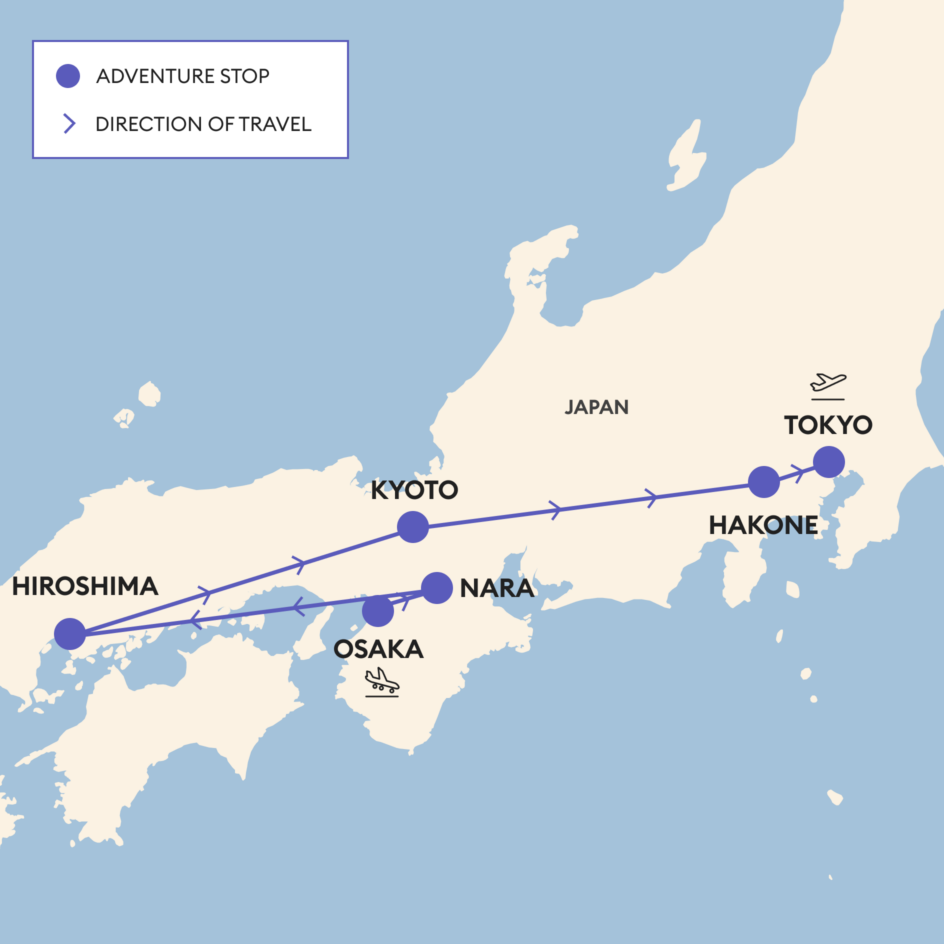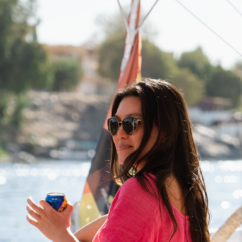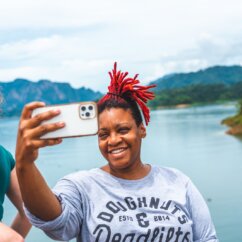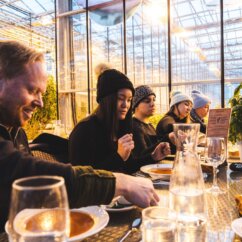-
Which airport do I need to fly in and out of? Plus airport code
Fly into Osaka International Airport (ITM) or Kansai International Airport (KIX). Fly out of Tokyo Haneda Airport (HND) or Narita International Airport (NRT).
-
What time do I need to arrive (in time for the welcome meeting)?
Please arrive at the airport by 3pm or earlier.
After arriving at either Osaka International (Itami) Airport (ITM) or Kansai International Airport (KIX), please proceed through immigration. Once you have collected your luggage, proceed to the exit of the security area where you will be met by a Flash Pack representative and taken to your hotel by taxi.
You will then meet at 4.30 pm in the hotel lobby, ready for your street food tour starting at 5 pm.
-
Are airport transfers included?
If you arrive on Day 1 of your adventure, or you’ve booked yourself a pre-night at the same hotel the adventure starts from, your airport arrival transfer will be included. Arrival transfers are private to Flash Pack and in groups depending on flight times, so you may have to wait in the airport for a short while.
However, if you’ve booked alternative pre-trip accommodation or are arriving by another mode of transport, you’ll have to arrange your own arrival transfer.
Please also note: in order to secure your place on the private transfer, you’ll need to provide your flight details to our Customer Experience team no later than 30 days prior to your adventure’s departure date. You’ll get automated email reminders about this, but the team won’t be chasing you. That’s why it’s key to get this information over in good time. If the details are provided later than 30 days pre-departure, you’ll have to arrange your own arrival transfer.
Departure transfers are typically not included due to travellers leaving at varying times. That said, your Pack Leader will happily help arrange departure transfers for you if required.
-
What will the food be like?
The food on this trip is authentically Japanese and may be challenging for Western palates.
At the ryokan (Japanese inn) in Hakone on Day 8, the food will also be simple and traditional – a unique way to experience true Japanese culture.
On Day 7, you’ll experience a kaiseki meal. This is an elaborate multi-course Japanese meal, equivalent to haute cuisine. Due to the very traditional nature of the dishes, the food will be unfamiliar to the Western palate (for example, fermented and raw fish). Even if the food isn’t quite to your taste, you can still enjoy the authentic cultural experience and beautiful presentation.
-
Are tips included?
Tipping is not part of Japanese culture so is not expected on this trip. Should you wish to tip your guide please do so with discretion and place the money in an envelope.
-
Do I need a visa?
Up-to-date visa and entry information can be found using our official partner, Sherpa, who can help you arrange a visa if needed.
You can also find essential travel advice – including security and local laws, as well as passport and visa information – on the government website of your home country:
Please be aware that passport and visa requirements can change before departure, so it’s important to stay updated with the latest information.
-
What vaccinations and medication will I need?
While we are not medical professionals and cannot offer personalised medical advice, we want to ensure you have a safe and enjoyable adventure. Here are some tips to help you prepare.
1. Consult with a healthcare professional
We recommend scheduling an appointment with your travel nurse or doctor at least eight weeks before your adventure. This will give you ample time to receive any necessary vaccines or medications.
2. Up-to-date medical advice
3. Government travel advice
4. Medication tips
If you take prescription medication, ensure you bring enough to last the entire adventure, plus a few extra days in case of travel delays. Carry a copy of your prescription with you in case you need to visit a clinic while abroad.
We hope this information will help you prepare for a safe and healthy adventure.
-
What do I need to know about luggage and public transport?
This itinerary makes extensive use of public transport, as it is the fastest and most reliable way to see Japan.
When you travel by bullet train, your luggage travels separately via Japanese post (called Takkyubin). This means that you send your luggage in the morning and get it back after noon the next day, so you will need to carry an overnight bag with you. Japanese post can only take one suitcase per person, so it’s best to pack light for this adventure.
Japanese post is used three times in total: from Osaka to Hiroshima, Hiroshima to Kyoto, and Kyoto to Tokyo.
-
What can I expect from the ryokan stays?
The ryokan stay during this itinerary offers an immersive experience in traditional Japanese culture. These accommodations are designed for cultural insight rather than luxury, providing a memorable contrast to Western-style hotels.
At the ryokan, you’ll sleep on futon bedding laid out by staff on a tatami mat at night, which is then tucked away each morning. Rooms do not have individual bathrooms; instead, guests share a large communal bath, often with spring water in “onsen” style (separated by gender). You’ll also follow Japanese custom by removing your shoes before entering your room and dining on a Japanese-style meal.
For customers paying the single supplement, single-use twin rooms will be provided. Many Flashpackers find these experiences a highlight, offering a unique and authentic connection to Japan’s heritage.
Please get in touch with our Sales Team if you would like further information on the above.
-
Will I meet with an atomic bomb survivor or memory inheritor?
The world’s first atomic bomb was dropped in Hiroshima in 1945. Survivors of the bombing are now quite old, and talking about the experience can take its toll. For this reason – depending on their health on the day – you may instead meet with a memory inheritor (a relative who inherited the testimony of the event), who will be able to share with you the stories of nuclear survivors.
-
Will this itinerary change?
Please be aware that the itinerary, activities and hotels are subject to change. These changes can happen with little notice due to availability, poor weather, seasonal changes, or other circumstances beyond our control – but we’ll always do our best to ensure it has little impact on your experience. From time to time, we may also make changes to your itinerary to try out new ideas and keep things fresh and exciting.
-
Can you cater for dietary requirements?
Most dietary requirements can be catered for on this trip, however if you have a severe gluten allergy we suggest that you contact a member of our team before booking.
If you’re allergic to soy it may also be more complicated. Soy-free options are available everywhere, apart from at the Buddhist temple, where we will source an alternative meal for y0u.
There are an increasing number of vegetarian and vegan restaurants, especially in big cities, but the menu will be more limited away from urban areas.
-
What fitness levels do I need for this trip?
While this trip doesn’t include any strenuous activities, it does involve a lot of walking and using public transport. Flashpackers have been clocking up around 18,000 steps a day.
We recommend having a read-through of the itinerary above, and getting in touch if you have specific questions on fitness.
-
Are tattoos forbidden in Japan?
Tattoos are only forbidden when using public bathing facilities, such as onsen, pools, and group bathing areas in gyms and hotels. That means customers who have tattoos may be denied access from public facilities unless they can cover their tattoos. However, more and more onsen are starting to permit tattoos, especially in tourist areas, and having a tattoo won’t affect any of the other activities.




